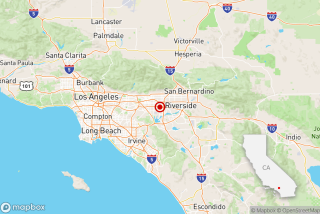Earthquake strikes San Francisco Bay Area
- Share via
A magnitude 4.0 earthquake was reported Monday morning in Piedmont, Calif., near Oakland, according to the U.S. Geological Survey.
The temblor occurred at 6:49 a.m. Pacific time at a depth of 3.1 miles.
According to the USGS, the epicenter was two miles from Emeryville, Calif., three miles from Oakland, three miles from Berkeley and 64 miles from Sacramento.
The quake was felt most strongly in the East Bay, including Oakland, Berkeley and surrounding areas. Lesser shaking was felt in San Francisco.
There were no immediate reports of damage or injury. BART, the region’s rapid transit system, reported short delays.
“Although many calls continue, no reports of damage or injury in #Oakland,” Oakland police Lt. Chris Bolton said on Twitter.
Residents said the quake lasted only a few seconds and sounded like a tree limb cracking.
The quake was centered near the junction of the 24 and 13 freeways. Seven aftershocks followed.
The temblor appears to have occurred along the Hayward fault, which experts have long said could produce a devastating quake. The fault runs below heavily populated areas of the East Bay. The fault has produced some small quakes recently, including a 4.0 in Fremont in July.
Studies have estimated that a massive quake on the fault could cause $32 billion in damage and leave 20,000 dead and injured.
The Hayward fault, a major branch of the San Andreas fault system, runs for more than 60 miles from Fremont through Hayward, and from goal post to goal post underneath UC Berkeley’s football stadium. It runs underneath freeways and aqueducts and close to Bay Area reservoirs, freeways and hospitals.
Geologists divide the fault into two portions: a northern stretch that runs from the Oakland and Berkeley border past El Cerrito, and a southern stretch running from Oakland to Fremont.
Historical records show that the southern portion of the fault ruptured in 1868, in a quake that was known as “the big one” until the 1906 San Francisco quake. It was long thought that the northern part of the fault had ruptured in a large 1836 earthquake.
This information comes from the USGS Earthquake Notification Service.
Read more about Southern California earthquakes.
Los Angeles Times staff writers Russ Mitchell and Ben Welsh contributed to this report.
ALSO:
Scorching heat breaks records in Southern California as 2 million flock to beaches
Crews battle 3 Southern California brush fires, but relief may be on the way
5 dead after executive jet and single-engine Cessna collide near San Diego’s Brown Field
More to Read
Sign up for Essential California
The most important California stories and recommendations in your inbox every morning.
You may occasionally receive promotional content from the Los Angeles Times.











